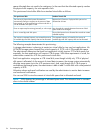
Disk types
The disk type specifies the type of physical disk drives that can be included in a disk group. The
types are:
Online disk type. All physical drives must be Fibre Channel or enterprise SAS drives. This disk type
provides first tier performance and reliability.
Near-online disk type. All physical drives are lower cost, lower performance hybrid Fibre Channel
or midline SAS disk drives. Hybrid drives are dual ported, Fibre Attached Technology Adapted
(FATA) drives. This disk type provides second tier performance and reliability.
Solid state drive disk type. All physical drives must be solid state drives (SSD). This disk type
provides first tier, very high performance and reliability.
Disk type support varies with HP XCS controller software versions. The following table summarizes
support and typical uses.
Solid state driveNear-onlineOnlineFeature
XCS 09500000 or laterAll versionsAll versionsXCS support
Solid state drivesFATA/SAS drivesFibre Channel/SAS drivesPhysical disks
Typical uses
Preferred usagePreferred usagePreferred usageDisaster tolerance
Preferred usageDisk-to-disk backup
Preferred usageDisk-to-tape backup
Preferred usagePreferred usageFrequent file access
Preferred usageInfrequent file access
Preferred usagePreferred usageHigh performance
Preferred usageVirus attack recovery
Disk group types
When a disk group is created, it is assigned a disk group type: basic or enhanced (default).
EVA supportSupported Vraid levelsDisk group type
EVA4000/4100/4400/6000/
6100/6400/8000/8100/8400
Vraid0, Vraid1, and Vraid 5Basic
EVA4400/6400/8400 P6300/P6500 EVAVraid0, Vraid1, Vraid5, and Vraid6Enhanced
General guidelines
One disk group (the default) is created when the system is initialized. You can add disk groups as
needed.
• Each physical disk drive can belong to only one disk group.
• A single disk group may contain all the physical disk drives in the storage system.
• Multiple virtual disks can be created in a disk group, up to the disk group's capacity.
• Each virtual disk exists entirely within one disk group.
Disk groups 27


















